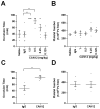Targeting the anionic region of human protease-activated receptor 4 inhibits platelet aggregation and thrombosis without interfering with hemostasis
- PMID: 24888424
- PMCID: PMC4127092
- DOI: 10.1111/jth.12619
Targeting the anionic region of human protease-activated receptor 4 inhibits platelet aggregation and thrombosis without interfering with hemostasis
Abstract
Background: Human platelet activation and aggregation is a complex process. To date, many therapies have been developed targeting proteins that mediate this process to prevent unwanted activation. However, the current standard of care for acute coronary syndromes still has limitations, including bleeding risk.
Objective: To evaluate the protease-activated receptor 4 (PAR4) anionic cluster as a viable antiplatelet target by using a polyclonal antibody (CAN12).
Methods: We used western blotting, aggregation and secretion ex vivo to evaluate the ability of CAN12 to interact with PAR4 and inhibit platelet activation. The effects of CAN12 in vivo were evaluated with the Rose Bengal arterial thrombosis model and two models of hemostasis.
Results: CAN12 was able to interact with human PAR4 and delay PAR4 cleavage. In addition, CAN12 inhibited thrombin-induced human platelet aggregation and secretion in a dose-dependent manner. The specificity of CAN12 was agonist-dependent. In vivo, we determined that CAN12 was able to inhibit arterial thrombosis, and, using two independent methods, we found that CAN12 did not influence hemostasis.
Conclusion: Targeting the extracellular anionic cluster on PAR4 is a viable novel strategy as an antiplatelet therapy.
Keywords: G-protein-coupled receptors; antibodies; hemostasis; platelet aggregation inhibitors; protease-activated receptor-4 protein, human; thrombosis.
© 2014 International Society on Thrombosis and Haemostasis.
Conflict of interest statement
Disclosure of Conflict of Interest
The authors state that they have no conflicts of interest.
Figures







Similar articles
-
Protease-Activated Receptor 4 (PAR4): A Promising Target for Antiplatelet Therapy.Int J Mol Sci. 2018 Feb 14;19(2):573. doi: 10.3390/ijms19020573. Int J Mol Sci. 2018. PMID: 29443899 Free PMC article. Review.
-
Inhibition of protease-activated receptor 4 impairs platelet procoagulant activity during thrombus formation in human blood.J Thromb Haemost. 2016 Aug;14(8):1642-54. doi: 10.1111/jth.13293. Epub 2016 Jun 22. J Thromb Haemost. 2016. PMID: 26878340
-
Lipid Receptor GPR31 (G-Protein-Coupled Receptor 31) Regulates Platelet Reactivity and Thrombosis Without Affecting Hemostasis.Arterioscler Thromb Vasc Biol. 2021 Jan;41(1):e33-e45. doi: 10.1161/ATVBAHA.120.315154. Epub 2020 Dec 3. Arterioscler Thromb Vasc Biol. 2021. PMID: 33267659 Free PMC article.
-
Blockade of protease-activated receptor-4 (PAR4) provides robust antithrombotic activity with low bleeding.Sci Transl Med. 2017 Jan 4;9(371):eaaf5294. doi: 10.1126/scitranslmed.aaf5294. Sci Transl Med. 2017. PMID: 28053157
-
Inhibitors of protease-activated receptor 4 (PAR4): a review of recent patents (2013-2021).Expert Opin Ther Pat. 2022 Feb;32(2):153-170. doi: 10.1080/13543776.2022.2034786. Epub 2022 Feb 16. Expert Opin Ther Pat. 2022. PMID: 35081321 Review.
Cited by
-
Protease-activated receptor 4: from structure to function and back again.Br J Pharmacol. 2016 Oct;173(20):2952-65. doi: 10.1111/bph.13455. Epub 2016 Mar 10. Br J Pharmacol. 2016. PMID: 26844674 Free PMC article. Review.
-
Production and characterization of polyclonal antibodies to human recombinant domain B-free antihemophilic factor VIII.Turk J Biol. 2017 Dec 18;41(6):857-867. doi: 10.3906/biy-1704-10. eCollection 2017. Turk J Biol. 2017. PMID: 30814851 Free PMC article.
-
PAR4 (Protease-Activated Receptor 4): PARticularly Important 4 Antiplatelet Therapy.Arterioscler Thromb Vasc Biol. 2018 Feb;38(2):287-289. doi: 10.1161/ATVBAHA.117.310550. Arterioscler Thromb Vasc Biol. 2018. PMID: 29367229 Free PMC article. No abstract available.
-
Chronic, not acute, skin-specific inflammation promotes thrombosis in psoriasis murine models.J Transl Med. 2015 Dec 16;13:382. doi: 10.1186/s12967-015-0738-z. J Transl Med. 2015. PMID: 26675482 Free PMC article.
-
Protease-Activated Receptor 4 (PAR4): A Promising Target for Antiplatelet Therapy.Int J Mol Sci. 2018 Feb 14;19(2):573. doi: 10.3390/ijms19020573. Int J Mol Sci. 2018. PMID: 29443899 Free PMC article. Review.
References
-
- Coughlin SR. Thrombin signalling and protease-activated receptors. Nature. 2000;407:258–64. - PubMed
-
- Steinhoff M, Buddenkotte J, Shpacovitch V, Rattenholl A, Moormann C, Vergnolle N, Luger TA, Hollenberg MD. Proteinase-activated receptors: transducers of proteinase-mediated signaling in inflammation and immune response. Endocr Rev. 2005;26:1–43. - PubMed
-
- Vu TK, Hung DT, Wheaton VI, Coughlin SR. Molecular cloning of a functional thrombin receptor reveals a novel proteolytic mechanism of receptor activation. Cell. 1991;64:1057–68. - PubMed
-
- Nanevicz T, Ishii M, Wang L, Chen M, Chen J, Turck CW, Cohen FE, Coughlin SR. Mechanisms of thrombin receptor agonist specificity. Chimeric receptors and complementary mutations identify an agonist recognition site. J Biol Chem. 1995;270:21619–25. - PubMed
-
- Keularts IM, van Gorp RM, Feijge MA, Vuist WM, Heemskerk JW. alpha(2A)-adrenergic receptor stimulation potentiates calcium release in platelets by modulating cAMP levels. J Biol Chem. 2000;275:1763–72. - PubMed
Publication types
MeSH terms
Substances
Grants and funding
LinkOut - more resources
Full Text Sources
Other Literature Sources
Medical
Molecular Biology Databases

